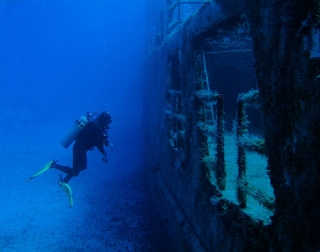There are times when natural orientation isn't feasible: night dives, navigating between waters, sandy seabeds, etc.—these are situations where nature offers no reliable reference points, and we must trust the compass, a simple yet invaluable tool for diving. By combining your natural orientation skills with this instrument, questions like "Which way am I going?" and "How do I get back?" will no longer be a mystery.
The knowledge we aim to share is to help you enjoy your dive and find your way back safely. We don’t expect you to obsess over this tool or let it overshadow your dive experience.

Types of Compasses
The compass is a simple instrument that uses a magnetic needle aligned with the magnetic North to guide us accurately to our desired destination. Underwater compasses follow the same principles as land-based ones but are housed in a sealed cylindrical case filled with liquid to make them pressure-resistant.
There are several models of compasses, but it’s crucial that they feature a rotating bezel with markings to centre the magnetic needle and simplify use. Most models include a lubber line—a reference line drawn on the compass surface to help maintain your desired heading.

The market offers several models:
- Needle compass without a bezel. The most basic type. It consists of a cylindrical case with a magnetic needle pointing North but lacks a bezel or lubber line. While affordable, it’s not recommended for diving unless you’re prepared to constantly monitor it or jot down headings on a slate.
- Needle compass with a bezel. Similar to the above but includes a rotating bezel with markings to align the North needle. A key advantage is that when viewed from above (like a watch), the needle remains stable with minimal oscillation. Some models feature a side window for easier reading and a lubber line.
- Disc compass with a bezel. Here, the entire dial is mobile, with a painted needle indicating North. These models have a side window for reading, as the moving disc makes overhead readings (like a watch) impractical due to oscillations. They include a lubber line and adjustable bezel.
- Digital compasses. These integrate computerised navigation, allowing you to plan and store up to 9 routes. They feature an integrated timer, course tracking with correction displays, and more—essentially underwater GPS. Ideal for frequent divers, but if used sporadically, a refresher of the manual is advised.
Before starting your dive, take your initial heading from land to simplify your return. Consistency is key: a slight deviation underwater can translate to hundreds of metres off course, depending on distance.

Most models can be worn on the wrist or mounted on a console. Wrist placement offers easier use, while consoles are more comfortable. Considering the number of instruments strapped to your arm, many divers now prefer consoles.
Taking Bearings from Land
For wrist placement, extend the arm opposite the compass and align it with your body’s central axis. Rest the compass-bearing arm on your elbow joint, ensuring the side window (if present) is at eye level, using your extended arm as a sightline. Align the lubber line with your target dive point, then centre the North needle within the bezel markings.
Each time you realign the North needle with the bezel, the lubber line will reaffirm your direction. Always hold the compass perpendicular to your body—tilting it can impede the needle’s movement and cause errors.
For console-mounted compasses with side visibility, align them with your body’s centreline.
The critical point is consistency: use the same placement (centred, perpendicular, and level) for taking bearings on land and underwater.

Using It Underwater
As mentioned earlier, we don’t want your dive reduced to staring at this tool—use it as an aid, not a crutch. Mastery isn’t the goal; practicality is.
- Point-to-point navigation. In clear waters, align the compass with a memorable seabed feature ("Point A") using your pre-dive heading. Explore the area between your start and Point A, then repeat the process to "Point B." Depending on visibility, this zone can be vast. How often did you check the compass? How much did you explore?
- Reciprocal heading. On the surface, set your desired heading by fixing the North needle within the bezel. Follow this heading, optionally using point-to-point navigation. To return, rotate 180° and align the South needle with the bezel—the lubber line now guides you back.
- Squares and triangles. These may seem unnecessary until an exploratory dive proves otherwise. Squares involve memorisable headings (e.g., 360°-270°-180°-90°). Fix the needle to your chosen direction, optionally using point-to-point navigation. Track distance (as covered in our natural orientation guide), then execute three 90° turns (left or right, consistently) to return. For triangles, two 120° turns suffice.

Supplement with Natural Orientation
Nature provides ample cues for the observant diver. Even with a compass, integrating natural references ensures you won’t get lost.
Trust Your Compass
If your instincts clash with the compass in challenging conditions, ignore them. The compass won’t fail you.












